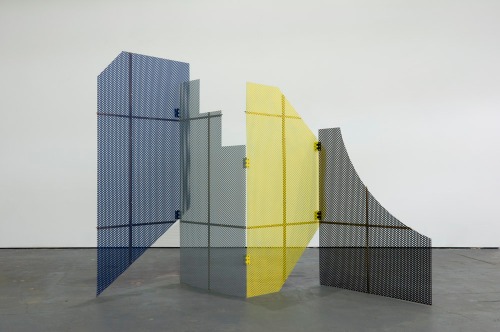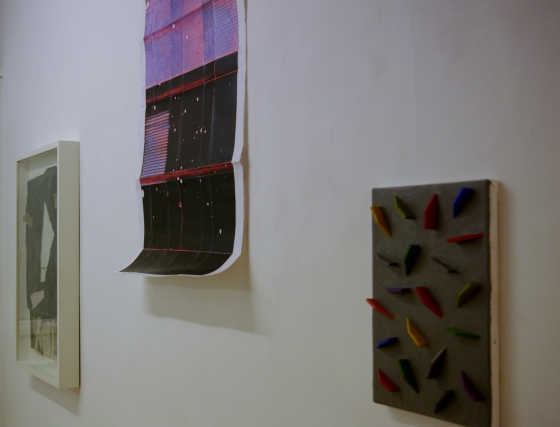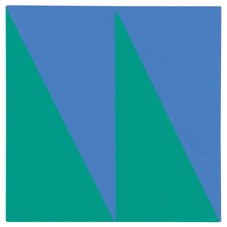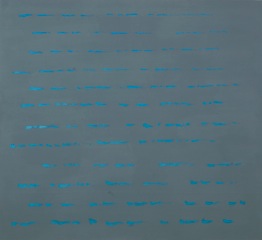Posts Tagged ‘constructivism’
Reflections on the Paintings and Constructions of Natalie Dower
A recent show I wish I had been able to visit, unfortunately I never managed to get there, was Reflections, Natalie Dower, at Eagle Gallery. There’s a good review of it at Saturation Point in which James Campion discusses the selection of works, reflecting on some individual pieces, specifically the Spiral Track works (1984), Colour Spiral Track no.2 (19) and Jungle Sphere, (1988), and briefly considers Dower’s relationship to the tradition of Constructivist and Systems art.
The exhibition, drawing from Dower’s career of over 40 years, and presenting recent paintings hung in counterpoint to selected historic works, including a selection of intricate reliefs that have not been exhibited since exhibitions at the Curwen Gallery, would have been an invitation to reflect on the connections between works from the eighties up to the present day. Even without a visit, in surveying material available online (the Saturation Point review, an Eagle Gallery website summary, the catalogue with images of the work and an essay by Laurence Noga), I am immediately impressed by Dower’s constancy of purpose along with the way that the relatively simple numerical systems she employs have the power to generate their own forms, almost even without the input of an artist. However, there is an artist here, constantly making choices, experimenting, offering feedback, thus contributing to that larger system, of which each work is a part, a meta-system if you will.

Natalie Dower, Travelling Star, 1996, oil on panel, 21.2 x 21.2 cm. Dudeney Circle, 1989, avonite, 31 x 31 x 4.5 cm. Images copyright of the artist, by courtesy of Eagle Gallery
Not actually visiting, I can imagine seeing the work, and I can also remember other works by Dower that I have seen before, like the one I saw here once at the Eagle Gallery, and where, in a conversation with the gallery owner Emma Hill, she noted the beautiful, subtly “faulted” quality of the painted surface. It wasn’t the charming oil on wood Hybrid from this show, but it so easily could have been. I now know enough about Dower’s paintings to guess that they share similar qualities. To really experience them however, does mean getting up close and seeing them first-hand.

Natalie Dower, Hybrid No. 2, 2007, oil on wood, 28.4 x 26 cm. Image copyright of the artist, by courtesy of Eagle Gallery
In the excellent publication Natalie Dower Line of Enquiry Alan Fowler summarizes the distinctive features of Dower’s work, in comparison with other systems artists, as displaying “a greater lyricism, a more varied use of colour” as well as “a freedom from the strictly orthogonal imagery that characterized the work of many earlier constructivist artists”. I think the “faulted-ness”, specifically in the paintings, is part of what might be included in the idea of the lyricism of Dower’s style.
Some think of the slippage between concept and execution, especially when very slight, as in Dower’s paintings, as a particularly human trait (see comments by Richard Guest on a previous blog post, though referring to quite different content). I think they are right. However, isn’t pure abstract thought also entirely human? (Cogito ergo sum).
For too much of my life I considered “mental arithmetic” as an enemy, a bully to be avoided, because I knew I couldn’t subdue it in open conflict. I put it down to the method of rote learning that disagreed with me as a child, and to the threat of punishment for getting my multiplication tables wrong. That beauty could reside here was unthinkable. That was until I started to notice the pleasurable rhythm of “seven sevens are forty nine” or “six sixes are thirty six” (I may never know why “six fours are twenty four” and in fact most of the other lines of the poem, didn’t have quite the same swing and therefore weren’t as memorable). Then one day one of the clever girls in my class showed me a real table (I mean a matrix not furniture) that she had drawn and coloured-in rather attractively, numbering 1 to 12 along the top and down the side and displaying plain as day the multiplication tables, even making it possible to follow a line say from 4 along the top and 6 along the side and find in the cell where they joined the number 24. It was magic, and it was beautiful: epistemology and aesthetics combined!
I am in no way comparing this visual table with the look of Dower’s paintings, nor suggesting that her work is a demonstration of numerical or arithmetic processes, simply that the sudden discovery of the beauty of number, via the visible chart has some resonance with my experience of beauty in Dower’s art.

Natalie-Dower, Spin Off, 2015, oil on board, 13.25 x 18.9 cm; Three Triangle Series: Five Colours 2015, oil on canvas, 43.5 x 43.5 cm. Copyright of the artist image by courtesy of Eagle Gallery
Is there in each painting and construction a physical manifestation of thought: logic apprehended by the senses, not so much “word made flesh” as perhaps number made material? I have written before about the highly pleasurable experience of attempting to recover the numerical system that spawned a particular painting or relief, and only sometimes thinking I may have succeeded. I do think this is an important aspect of viewing work of this kind, though it is by no means the only thing.
It’s Dower’s work that has me reflecting on the beauty of say a root 2 rectangle, or even a double square, and that’s when I am viewing a specific piece, and also when I am thinking about a work that I once viewed. The numerical system, now communicated, becomes available to my thought independently of the artwork, as if there were such a thing as a “realm of pure thought”. Now what had become material becomes immaterial, non physical, abstract thought.
Dower has said “I want the image to be able to attract and hold the attention of the viewer” her objects/images long since attracted my attention, and continue to hold it beyond the physical viewing of artworks. Nevertheless I do wish I had actually seen the show!
System Painting Construction Archive at Lion and Lamb Gallery
A detour on my way home from a day’s work brings me once again to that wonderful informal space The Lion and Lamb Gallery, in the back room of a London pub, where I get to see System Painting Construction Archive, curated by Andrew Bick.
Pint in hand, I view works by Andrew Bick, Stuart Elliot, Robert Holyhead, Clare Kenny, Maria Lalic, Karim Noureldin, David Rhodes, Cullinan Richards, Brandon Taylor, exhibited alongside a ‘museum’ of printed matter related to British Construction and Systems Art. In the gallery notes Bick explains that the artists were invited to “place their work alongside”, rather than respond directly to the archive.
Bick’s OGV (grid GW), does directly reference a Gillian Wise image shown in one of the vitrines, and acknowledged in the ‘GW’ of the title.
Its presentation, straddling the corner of the room, less directly references the Russian Tradition via Malevich’s famous Black Square. That tradition clearly also having resonance for Maria Lalic who has been working with the monochrome for some time. Here in her Sevres Blue Landscape Painting (Le Chemin de Sevres. Corot. C1855 – 65), she reintroduces the horizon line, but it is made by the joining of two monochromes, a lower one in brown and an upper one in blue. The non-objective is simultaneously posited and negated: two monochromes entirely abstract, yet it is impossible not to make landscape associations.
Clare Kenny’s Snow Blind appears also to toy with the propositions of ‘concrete’ and ‘representational’ . I think it is collaged from photographs of windows with blinds, the abstract lines and colours occupying my attention along with blotches or painterly stains, which could be read as ‘errors’ in the printing process, or possibly photographed (‘real’) snow flakes through a window pane. I am reminded of that old notion of painting as ‘a window on the world’, this particular ‘window’ being also physically blind-like, in that the paper support is folded, creating a material object that could function as a blind, obscuring the window.
The work by Cullinan Richards also has obscured ‘subject matter’. The title Paula Radcliffe in Disappointing 4th Place is taken from a newspaper article just showing towards the bottom edge of the piece. Possibly the newspaper was used to rest the art work on whilst it was being made and, getting stuck to it, it became an integral part by the end of the production process, almost as if the article became accidental content even whilst what was being constructed was rooted in the universal ‘content’ of the geometric.
Brandon Taylor’s Painting for CB is a construction with coloured wood pieces stuck to a painted grey ground on canvas that reads like a painting. I have the impression that the composition follows a rational formula but I can’t actually work it out. I find that I am counting the pieces, checking whether they are similar in shape and size and how many times each colour is repeated.
I am in a similar mode when looking at the paintings by David Rhodes and Stuart Elliot, attempting for example to work out in what order the lines in Rhodes’ 2.5.2013 (1) were masked and painted on the raw cotton duck. It’s an impressive painting that could have been executed in three sections, and even if it wasn’t I perceive it as comprising three informal ‘panels’, each with black and off-white lines in alternating directions, resulting in an overall “N” shape. It packs a punch, yet there is softness in the lines as a result of the way the paint has gently bled through the masking tape, and a richness of colour that is hidden by the description “black and white”. Likewise with Stuart Elliot’s Untitled (73), where blackboard paint has been applied to primed canvas before being stretched and the image, in so far as there is an image, looks to have been constructed by scumbling the paint over the bars of a wooden stretcher, creating impressions of the stretcher, not only at the edges but through the centre of the canvas, in numerous directions. Again, to say it is black and white would deny the subtlety and warmth of the colours that are nearer to warm greys on ochre.
In Robert Holyhead’s Untitled (yellow), a variegated yellow ground is interrupted by two, flatly painted, white triangular shapes reading as cut-outs, accompanied by a vertical line of a different yellow, running along the right hand edge branching out at top and bottom into two triangles causing the yellow of the ground to recede, and creating a lively ambiguous space.
The two beautiful drawings by Karim Noureldin, Evo (09-11040) and Evo (07-11009), both pencil on paper, look like a geometric starting point is being empirically explored or unfolded through a series or sequence. One of them has a central mass that could be a sculptural object in a space, whereas the other has a vertical zig zag, more rhythm than object.
My attention alternates between wall and vitrine. I read texts on or by Jeffrey Steele, Gillian Wise, Charles Biederman, Anthony Hill, Kenneth Martin etc. and, wanting to turn the pages, I have the sense of a past that is locked, only partially accessible via faded documents, memory and influence, as if the works on the wall are familiarly connected to the archive material or they can be interpreted as having evolved from a “constructive context”, some more consciously connected to the base than others, like the system formula that eludes my attempt to discern it, or like Noureldin’s drawings wending their way through various permutations, continually repeating and changing, awareness of the past leading to an informed openness to an unknown future.
System.Painting. Construction. Archive is showing at Lion and Lamb Gallery until 15 June 2013, and there’s a talk on 8 June at 5pm.
Systems at Lion and Lamb and William Scott at Hepworth, Wakefield
I wish I was going to the opening of this show at the Lion and Lamb Gallery tonight.
I do hope to get along to see it before it closes on 15 June and, assuming I manage it, I will write about it.
In the opposite direction travel-wise there is also an interesting show starting up at the Hepworth, Wakefield this evening and I will be going along to that (it’s much closer to where I live. If there was nothing in it as far as travel and cost are concerned I would be in a dilemma as to which one to go to).
and I hope to write about this one too during the next few days.
Line & Circle and Edwina Leapman at Annely Juda Fine Art
Although to speak about silence is to risk obscuring the very experience one might wish to elucidate, to keep silent is to risk it going unappreciated. I feel similarly about the wonderful exhibition(s) currently on show at Annely Juda Fine Art. I will be careful not to say too much, but I must say something. I will keep quiet about the wonderful space on the fourth floor with a skylight that is perfect for viewing the new paintings by Edwina Leapman, and say nothing about the beauty of the works in the Line and Circle exhibition on floor three. It’s ages since I saw Naum Gabo‘s linear constructions and constructions in space, and I had forgotten just how captivating they are. Was it in the 70s that there was a big show of these somewhere and we spent ages peering at tiny constructions in glass cabinets and glass covered plinths? And whilst looking, really looking (the response that Gabo achieves so consistently, not just for me, everyone seems to be studying so intently) it is silence that accompanies us.
So, I shan’t say a thing about the amazing paintings here by Friedrich Vordemberge-Gildewart (an artist only recently brought to my attention by Terry Greene in a recent blog post), Composition N. 204, 1944/5, demanding silent contemplative viewing, like the Max Bill painting pura III, modest in size at just over a foot square, and containing almost no detail, the space divided in half down the centre and each half being divided diagonally from upper left to lower right resulting in four triangles, two in a colour approaching indigo and two in green, also resembling a zig-zag or ‘W/M ‘shape.
Impossible to determine which form is figure and which is ground, it shifts continually, from green figure against blue ground to blue figure with green ground, the colour relationship between them seeming somehow to be just right, as if there was such a thing as “correct”. Motion is arrested as I fix my attention on this object/image. It’s not just that the experience is a silent one, it’s more that the painting is the visual equivalence of silence: shifting, dependent on our perception of it, between presence and absence.
The other, much larger, Max Bill painting on show here, rotation around expanding white, a brightly coloured diagonally oriented canvas, equally interesting, seems a little ‘noisier’. Perhaps it’s all that visual excitation. Similarly with the marvelous painting by Kenneth Martin from his Chance, Order, Change series: although quietude continues to attend my viewing, it seems slightly ‘noisier’ somehow than pura III; It has a ‘buzz’ about it. Based on preliminary drawings, this series of paintings is highly programmatic and yet incorporates chance, which defines the position of the lines and their sequence. The points of intersection on a grid of squares are numbered and the numbers written on cards which are then picked at random. A line is made between each successive pair of numbers. I am unsure how the colours are determined but I think I am right in saying that where a line has been crossed by another its colour is changed.
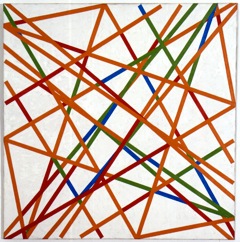
Kenneth Martin, Chance Order Change 20, Symmetry B, 1981, oil on canvas, 91.4 x 91.4cm, image by courtesy Annely Juda Fine Art
It’s a lively painting, and I am enjoying seeing it here in this room along with others that share with Martin an affinity with the tradition of constructivism (some more some less so: Ben Nicholson, Antony Caro, Josef Albers, Laszlo Moholoy- Nagy, Naum Gabo, Kazimir Malevich and Olga Rozanova ). I am also aware that it belongs in a series and I would like to see more of the series to place it within it’s own more specific context. But most of all I am enjoying the dialogue that this painting seems to invite me into. Perhaps that’s why I say its a noisier painting than some of the others: here I am talking to it about the process followed for its own production.
On the fourth floor Edwina Leapman‘s paintings also encourage thoughts about the process of making them, and the series context is also present: 15 paintings all made in 2012, all of two colours with a ground on which is drawn a sequence of horizontal lines. I have the impression that on each line the brush is loaded with paint and the paint deposited along the line until the brush is empty and then re-loaded to recommence on the line below. It looks as if the position of the line has been determined beforehand but the way the painted line looks is determined only by the process of drawing the brush across the coloured canvas.
In some of the paintings the ground and the line colour contrasts in hue and sometimes they match, but they are generally closely matched in tone. Although I feel drawn into that conversation about process, and even more so having seen the Max Bill painting pura III and wanting to compare and contrast them, they do then bid me to become silent again as I view.
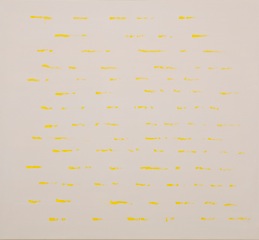
Edwina Leapman, Untitled, 2012, acrylic on canvas, 168 x 183 cm, image by courtesy Annely Juda Fine Art
They have amazing optical qualities, that must be ‘simply’ the result of the colour and close tonal relationships. That so much sensation can arise from so little intervention I find surprising, also that each painting has a distinct character of its own, vastly different from the others whilst in structure being entirely similar.
It’s true that appreciating these is something more for experience than for words, and also that their visual charge ( I want to say power but that suggests something much more brash and not ambiguous enough for these) is extremely difficult to put into words. So I will cease my speaking and continue to look on in silence.
Edwina Leapman New Paintings is showing until 28 March and Line and Circle until 23 March.
Duke Street Tetractys
I had the idea for this tetractys when I was working at Wallacespace on Duke Street, St Pancras
I was clearing away the marker pens after the day’s work when I noted this sequence of colours: yellow + blue = green, complementary = red, adjacent to orange made by adding yellow, complementary = purple. I made a sketch that same day and then during the next few days completed a version in acrylic and marker pen on acrylic paper, currently on display at First Come First Served at The Lion and Lamb Gallery. More recently I painted the version shown above, on board using narrower lines (possibly too narrow).
(The photo has a slight red cast due to the direct sunlight. My fairly good camera has a limitation of having automatic white balance only.)
The Empiricism of Michael Kidner: Dreams of the World Order
I have written before about two approaches to making an abstract painting. We could call one of them ‘dialogical’: the artist enters a conversation with the materials in a state of ‘not knowing’ or with only a vague idea of what s/he is going to paint. The process becomes one of responding to previous ‘moves’, most of the decisions about the work being made during its production. The other strategy is pre-planned, with decisions being made before any paint is applied to a support. If the first is in danger of becoming ‘automatic writing’ the second may suffer from being too predictable. Perhaps they correspond to what Michael Kidner referred to as “the gestural approach”, which to him seemed “foreign to Western tradition” and lacked the possibility to develop, as opposed to the “preconceived image” which he thought “seems contrived”. Instead of either he proposed an empiricism of “imagery through optics” stating that “whereas a painting conceived in two colours can fairly easily be predicated in the mind’s eye, the addition of a third colour makes this impossible. The work necessarily becomes empirical.”
At Michael Kidner, Dreams of the World Order – Early Paintings at Flowers Gallery until 20 October 2012, this empiricism is evidenced in the relationship between paintings shown in the downstairs galleries and between those paintings and the wonderful (preparatory?) works on paper that are shown upstairs.
The exhibition explores four of Kidner’s sub-themes: After Image, Stripe, Moirè and Wave, described in the catalogue as “progressive experiments with optical effects and rational procedures, inspired by his preoccupation with how space, pattern and form function” and explaining that “a year after Kidner’s death in 2009, a number of rolled up paintings were discovered in his Hampstead Hill Gardens studio. These have now been re-united with this iconic body of work”. Many of the works on view in this exhibition are being shown for the first time.
It is a real treat being able to see them together, and to discover that some of the works on paper are double-sided (thank you to the show’s curator Amie Conway for demonstrating this).
One of the paintings I am particularly impressed by today is Circle after Image, 1959-60. Seeing an after image presented simultaneously below the image is a strange contradiction, the equivalent of an oxymoron like “objectively subjective”, and caught in this contradiction I am made aware of the temporal dimension of viewing a painting, and of vision in general. The after image is there represented by the artist yet as I view it, after about 20 seconds, I cannot help but project my own after image of the upper half of the canvas into the lower half.

Circle after Image 1959-60, Oil on canvas, 151.5 x 124.5 cm / 59¾ x 49¼ in, AFG 42498, ©The Estate of Michael Kidner, courtesy Flowers Gallery, London
I feel sure that Slavoj Zizek had something different in mind when he said that the ethical duty of the modern artist is to confront us with “not objective reality but the objectively subjective” though it does seem to apply. It is almost as if there is a double constructivism at play here, the paintings themselves being situated within that tradition, that also produce a keen awareness in the viewer of the part s/he plays in constructing visual reality.
Seeing the smaller after image paintings on paper in the upstairs gallery gives an insight into Kidner’s empirical working method, yet I hesitate to label them ‘preparatory’ because they provide specific experiences that are similar but different to the larger painting, and highly interesting and enjoyable in their own right.
A painting for which I find no preparatory works, unless perhaps it should be grouped in the “towards moire” category is Raindrops, 1960, a wonderfully chaotic yet finely ordered painting.

Raindrops 1960, Oil on canvas, 97 x 122 cm / 38¼ x 48 in, AFG 42486, ©The Estate of Michael Kidner, courtesy Flowers Gallery, London
The clear circular motif seems to break down on prolonged viewing, and then as I notice the complementary coloured squares I realise that this too is based on after images, and indeed the ‘figures’ becoming unstable is in part due to my own after images that the painting provokes. There is also a small painting on paper entitled Moving Green from this same period that explores a similar theme. The after images do seem to pulsate and to move and there is also something ‘moving’ (in the emotional sense) about seeing them. I note my involuntary sigh that signals a change of state as I look at these beautiful paintings, yet my cognitive mind is an equal partner in the experience.
To my mind the work in this exhibition is proof, if proof were needed, that a rational, systematic (empirical rather than pre-conceived) approach to abstraction can result in works that are both emotionally charged and intellectually interesting. It could even be said that Kidner combines the opposing traditions of expressionism and constructivism. Although he criticised abstract expressionism for its “assault on the unconscious” there is something of Rothko’s feeling for colour in these paintings. Yet there is no mysticism or ‘spirituality’ here, even though there is Grace in the sense of the term that (following Aldous Huxley) systems thinker Gregory Bateson used of “integrating conscious and unconscious minds”.
(All images by courtesy of Flowers Gallery. My Zizek quote is taken from How to Read Lacan, chapter 4, my Bateson quote is taken from Steps to an Ecology of Mind, Part II and all my Kidner quotes are taken from the exhibition catalogue.)
Natalie Dower: Constructive Line of Enquiry
I wish I had seen the Natalie Dower exhibition Line of Enquiry at the Eagle Gallery in May. I became interested in her work after seeing the wonderful Fast track Through 44 points, at Lion & Lamb Gallery in June.
Well, I did the next best thing and bought a copy of the book that accompanied the show, published by EMH Arts London, 2012, with a preface by Mel Gooding and a text by Alan Fowler. I am enjoying it a lot.
Here’s a link to a summary with images at Abstract Critical, where in comments Alan Fowler says:
I find it fascinating that Dower – together with, among others, Jeffrey Steele, Peter Lowe and Gillian Wise – continue to carry into the 21st century an approach to abstraction which was prefigured 100 years ago by Kandinsky when he wrote in 1912 that he foresaw a time when the relationship between elements in a painting could “be expressed in mathematical form”, and concluded that “the time was approaching “when the painter would be proud to declare his work constructive
I also found this interesting podcast of an interview with Dower in relation to her paintings/constructions in the Government Art Collection. She comments on her artistic background, the notion of systems art, the Fibonacci sequence and the Dudeney Dissection. (It becomes clear that the interviewer is herself an artist, but I don’t know who it is.)
Chris Baker and Natalie Dower in “Double Vision”
The Double Vision show at Lion and Lamb Gallery, Hoxton has a lot to keep going back for, and I have at least one other trip planned before it closes on 14 July 2012.
Two paintings I want to see again are Natalie Dower‘s Fast Track Through 44 Points and Metan by Chris Baker. Both paintings seem to position themselves in a continuing relation to Modernism, as opposed to a break with it, and I guess this may be true of all of the paintings on show here. Maybe this is to state the obvious, it’s abstract art after all. But Modernism breaks down into a number of traditions even when we are within the general term ‘abstraction’.
Chris Baker seems to draw from many of those traditions, and I am not always entirely sure that they are ‘abstract’ as figurative elements sometimes find their way in, though not so with Metan. Is the title Old English? Others of his titles are similar. Could it be that the paintings reference an outmoded language, one that has lost its original meaning and can be plundered now for new ones?
It “draws from” quite literally, the lines seem excavated from a less than unified ground, or alternatively it is created by filling in the negative spaces allowing the linear structure to emerge. It is double in that it presents a strong figure/ground contrast, the light lattice like structure being figure against the dark ‘background’ that is actually ‘foreground’. It is also double in terms of the divided space, the structure bisecting the canvas down and across the middle (more or less) as well as in numerous other ways. The structure looks arrived at through trial and error, like a form trying to get out of the otherwise monochrome surface, and in getting out it bends the space, so that the bottom half recedes, giving the appearance of horizontality, whereas the top half extends upwards giving a vertical appearance. The bottom half of the structure could be the shadow of the top half if the lines corresponded, which they don’t so that interpretation is discarded, but then it reasserts itself, only to be discarded, it’s a cycle, a system, in a way.
I situate Natalie Dower’s paintings within the tradition of Constructivism and more specifically Systems art. One of the many things I appreciate about that approach is the unpredictable and un-work-out-able results that can be generated by logical means, or a pre-determined path. The great systems thinker Gregory Bateson’s question: “What pattern connects the crab to the oyster and the orchid to the primrose and all the four of them to me, and me to you?” seems to resonate with Dower’s aesthetic investigations, based as they are on the abstract pattern that connects all things. Mel Gooding recently said of her: “Like her ‘Systems’ comrades, Dower has worked in the knowledge that all nature – from the spiralling mechanics of the galaxies to the growth of a snail’s shell and the branching of a plum-tree – is governed by mathematical rules”. So when I look at the wonderful Fast track Through 44 points, I know that it is ordered by mathematical rules, I just don’t quite know what they are.

Natalie Dower, “Fast Track Through 44 Points”, 2008, oil on panel, 29 x 29cm, image by courtesy of Lion & Lamb Gallery
I approach it a bit like I might a puzzle, attempting to work out what is going on, except that I don’t care much for puzzles whereas I do care a lot for this painting and paintings of this kind. Possibly the title helps to solve it, though it could be a diversion. I am sure that the organisation of the line and points through which it passes as it journeys about the surface is not random, but I am unable to determine the rules for it. As I study the construction I feel sure that the ordering principle is staring me in the face but I just can’t see it. I realise that this may be saying a lot more about me and my slowness to catch on, than about the painting! Again the ‘figures’ (the bars and lines) look like they are the consequence of filling in the spaces with black, so that it is difficult to decide which are the positive and which the negative shape, though I think we would agree that we read the black as space and the lighter tones as structure, until we don’t. The support is shaped, therefore some of the bars are ‘real’ rather than drawn. I like the difference between the constructed edges and the drawn edges, and that the image extends beyond the confines of the square, confounding its identity as image and asserting its constructed-ness.
These are wonderful things to view, and I am looking forward to making another visit soon.
The other artists in this exhibition are: Dominic Beattie / Isha Bøhling / Ian Bottle / Katrina Blannin/ Alice Browne / Simon Callery / Keith Coventry / Tom Hackney / Jumpei Kinoshita / Hannah Knox / John McLean/ Sarah McNulty / Neil Mendock / Mali Morris/ Jost Münster / Selma Parlour / Geoffrey Rigden / Dan Roach / Danny Rolph / David Ryan / Estelle Thompson / Julian Wakelin.









